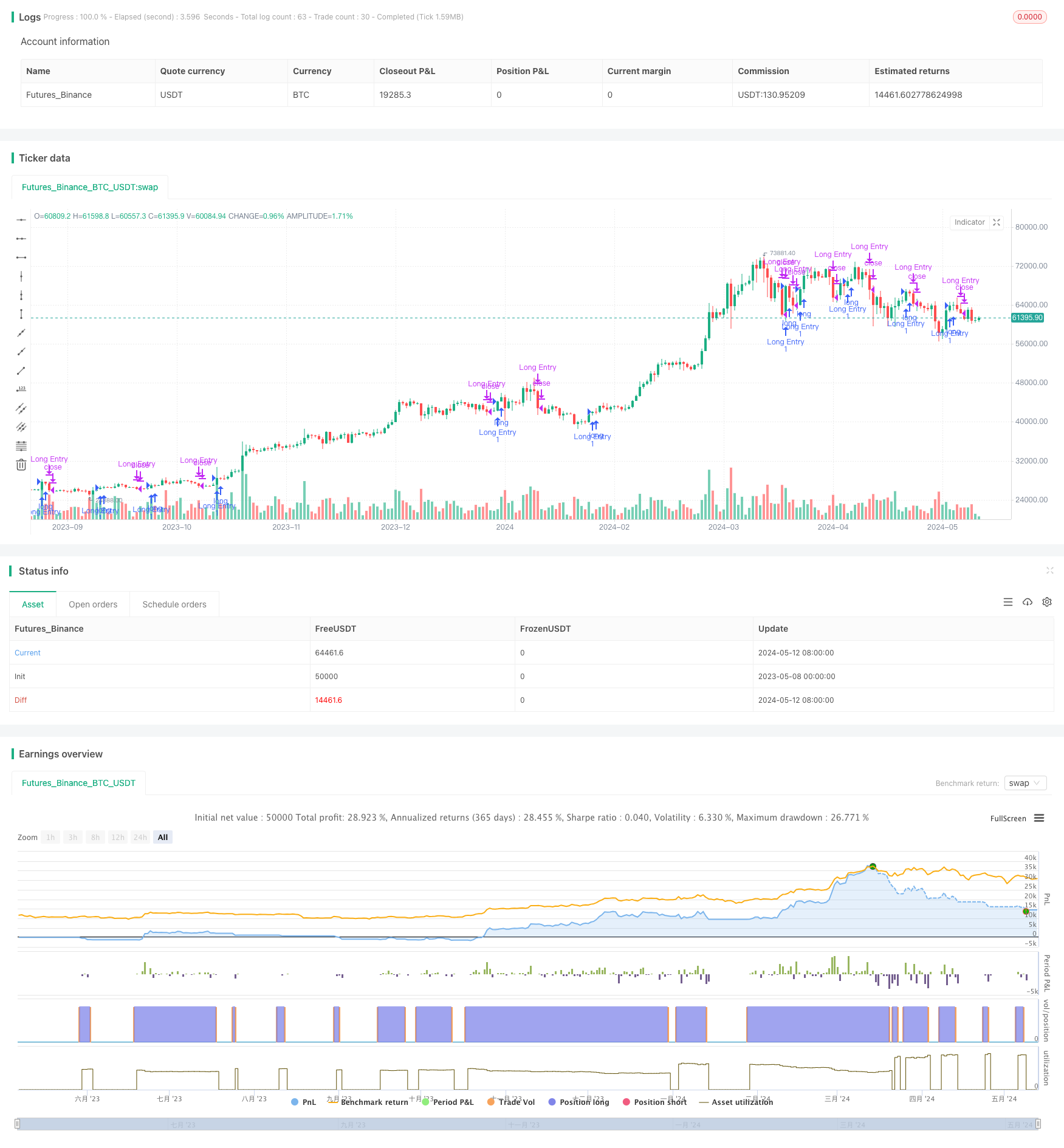
概述
双移动平均线交叉策略是一种常见的量化交易策略。该策略使用两条不同周期的移动平均线作为买卖信号,当短期均线上穿长期均线时买入,当短期均线下穿长期均线时卖出。该策略代码支持多种常见的移动平均线类型,如简单移动平均线(SMA)、指数移动平均线(EMA)、双指数移动平均线(DEMA)、三指数移动平均线(TEMA)、加权移动平均线(WMA)和成交量加权移动平均线(VWMA),并且可以灵活设置短期均线和长期均线的周期。同时,该策略还支持选择不同的价格类型来计算均线,如收盘价、最高价、开盘价、最低价、典型价格和中间价格。
策略原理
该策略的核心原理是利用两条不同周期移动平均线的趋势特性和滞后性来捕捉价格趋势。一般来说,短期均线对价格变化更敏感,而长期均线则相对滞后。当价格处于上升趋势时,短期均线会先于长期均线向上运动并最终上穿长期均线,形成”金叉”买入信号;反之,当价格处于下降趋势时,短期均线会先于长期均线向下运动并最终下穿长期均线,形成”死叉”卖出信号。通过捕捉金叉和死叉信号,该策略可以顺应价格的主要趋势方向进行交易。
策略优势
简单易用:双移动平均线交叉策略是一种简单易懂、容易实现的量化交易策略,适合新手traders学习和使用。
适用性广:该策略可以应用于各种金融市场和交易标的,如股票、期货、外汇、加密货币等,通用性强。
参数灵活:该策略代码支持多种常见的移动平均线类型和价格类型,用户可以根据自己的需求灵活设置参数,以适应不同的市场环境和交易风格。
趋势跟踪:通过两条不同周期均线的交叉信号,该策略可以较好地捕捉价格的主要趋势,有助于顺势而为、避免逆势交易。
策略风险
滞后性:移动平均线本质上是一种趋势跟踪指标,存在一定的滞后性,可能错过最佳的入场和出场时机。
震荡市中失效:在震荡市或者横盘整理行情中,价格波动较大,均线交叉信号频繁,可能导致策略频繁交易,造成高昂的交易成本和资金损失。
参数优化难:均线周期的选择对策略效果影响很大,但最优参数往往因市场状况不同而有所差异,很难找到放之四海而皆准的最优参数组合。
策略优化方向
引入趋势过滤:在均线交叉信号的基础上,可以结合其他趋势指标如MACD、ADX等进行趋势过滤,只在趋势明确的情况下进行交易,避免在震荡市中频繁交易。
优化止盈止损:在策略中加入合理的止盈止损逻辑,如移动止损、波动率止损等,以控制单次交易风险,提高策略的风险收益比。
动态参数优化:针对不同的市场环境,可以定期对均线周期等参数进行动态优化,使策略能够自适应市场变化,提高稳健性。
多因子组合:将双移动平均线交叉信号与其他有效的量化因子(如动量、价值、成交量等)进行组合,形成更加稳健有效的多因子策略。
总结
双移动平均线交叉策略是一种简单经典的趋势追踪策略,通过两条不同周期均线的交叉信号来捕捉价格趋势,适合趋势性市场。但该策略也存在滞后性和参数优化难等问题,需要结合其他方法进行优化和改进,如趋势过滤、动态参数优化、多因子组合等,以提高策略的适用性和稳健性。总的来说,双移动平均线交叉策略可以作为量化交易的基础策略之一,值得广大量化爱好者学习和研究。
/*backtest
start: 2023-05-08 00:00:00
end: 2024-05-13 00:00:00
period: 1d
basePeriod: 1h
exchanges: [{"eid":"Futures_Binance","currency":"BTC_USDT"}]
*/
// This Pine Script™ code is subject to the terms of the Mozilla Public License 2.0 at https://mozilla.org/MPL/2.0/
// © SustainableInvestment
//@version=5
strategy("Moving average strategy (이동평균선 전략)", overlay=true)
// === INPUTS ===
basisType = input.string(defval = "EMA", title = "MA Type: SMA, EMA, DEMA, TEMA, WMA, VWMA ",options=["SMA", "EMA", "DEMA", "TEMA", "WMA", "VWMA"])
shortLen = input.int(defval = 1, title = "Short MA Period", minval = 1)
longLen = input.int(defval = 20, title = "Long MA Period", minval = 1)
price = input.string(defval = "Typical", title = "Price Type : Close, High, Open, Low, Typical, Center ",options=["Close", "High", "Open", "Low", "Typical", "Center"])
// === BASE FUNCTIONS ===
// 가격 종류 설정
priceType(price) =>
Typical = (high+low+close)/3
Center = (high+low) / 2
price=="High"?high : price=="Low"?low : price=="Open"?open : price=="Typical"?Typical : price=="Center"?Center : close
// 이동평균선 종류 설정
variant(type, src, len) =>
v1 = ta.sma(src, len) // Simple
v2 = ta.ema(src, len) // Exponential
v3 = 2 * v2 - ta.ema(v2, len) // Double Exponential
v4 = 3 * (v2 - ta.ema(v2, len)) + ta.ema(ta.ema(v2, len), len) // Triple Exponential
v5 = ta.wma(src, len) // Weighted
v6 = ta.vwma(src, len) // Volume Weighted
type=="EMA"?v2 : type=="DEMA"?v3 : type=="TEMA"?v4 : type=="WMA"?v5 : type=="VWMA"?v6 : v1
longCondition = ta.crossover(variant(basisType, priceType(price), shortLen), variant(basisType, priceType(price), longLen))
if (longCondition)
strategy.entry("Long Entry", strategy.long)
exitCondition = ta.crossunder(variant(basisType, priceType(price), shortLen), variant(basisType, priceType(price), longLen))
if (exitCondition)
strategy.close("Long Entry","Long Exit")